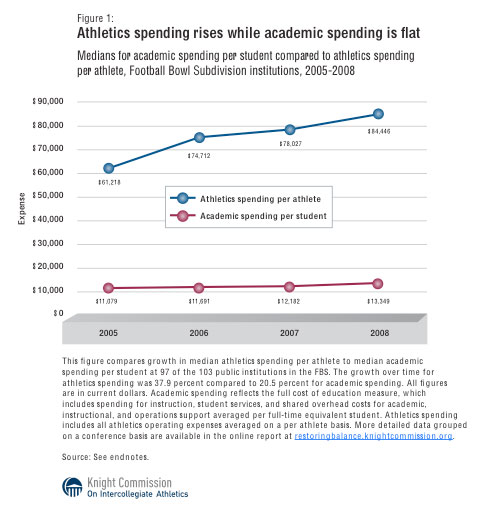This research paper primarily explores the question: How does the presence of big-time athletic programs compromise the intellectual integrity that is the basis of higher education?There is a current controversy surrounding the benefits that Div IA athletic departments bring to the university. In recent history there is evidence that suggests that the integrity of academics in higher education is dwindling on account of the presence of big time athletic programs. College is a place where students share a common goal of academic achievement, but the transition to the business of Division IA athletics shifts the focus of funding from education to athletics in order to ensure the success and prosperity of sports. As institutional funding is redirected to support the the athletics department, academics suffer; they become second class citizens to the sport culture. There is also the idea that big-time intercollegiate athletics contributes to the party-like atmosphere that exists on campus, further diminishing the focus on academics. With the threat of privatization breathing down the neck of institutions across the nation, there has been an increase in focus on money, which in turn, corresponds to the increase in a focus on sports as an alternate source of revenue; universities have lost sight of the mission of higher education. Although big-time athletics appears to be toxic to the intellectual community of higher education, its presence is a vital aspect of campus culture, and contributes greatly to the social environment. A balance must be met in order to ensure the academic mission of the university is not lost, and athletics is able to flourish without infringing upon education. It is possible that academics and athletics can coexist in the American institution of higher education.
Works Cited
Benford, Robert D. "THE COLLEGE SPORTS REFORM MOVEMENT: Reframing the “Edutainment” Industry." Sociological Quarterly 48.1 (2007): 1-28. Print.
Brand, Myles. "The Role and Value of Intercollegiate Athletics in Universities." Journal of the Philosophy of Sport 33.1 (2006): 9-20. Print.
Carey, Jack. "Knight Commission: Athletics Vs. Academic Spending Too Unbalanced." USA TodayPrint.
Dowling, William C. Confessions of a Spoilsport: My Life and Hard Times Fighting Sports Corruption at an Old Eastern University. University Park, PA: The Pennsylvania State University Press, 2007. Print.
Goidel, Robert, and John Maxwell Hamilton. "Strengthening Higher Education through Gridiron Success? Public Perceptions of the Impact of National Football Championships on Academic Quality." Conference Papers -- American Association for Public Opinion Research (2005): 1. Print.
Guarino, Mark. "Penn State Riot: If University can't Fire Joe Paterno, is Something Wrong?" Christian Science Monitor (2011): N.PAG. Print.
Kingsbury, Alex. "The Sports Fallacy." U.S.News & World Report 137.9 (2004): 70-. Print.
Pine, Nathan. "The Role of Athletics in the Academy: An Alternative Approach to Financial Investment." Journal of Sport & Social Issues 34.4 (2010): 475-80. Print.
Sigelman, Lee. "It's Academic-Or is it? Admissions Standards and Big-Time College Football." Social Science Quarterly (University of Texas Press) 76.2 (1995): 247-61. Print.
Sperber, Murray. Beer and Circus: How Big-Time College Sports is Crippling Undergraduate Education. 1st ed. New York, New York: Henry Holt and Company, LLC, 2000. Print.
Winston, Gordon C., and David J. Zimmerman. "Peer Effect in Higher Education." National Bureau of Economic Research (2003)Print.




